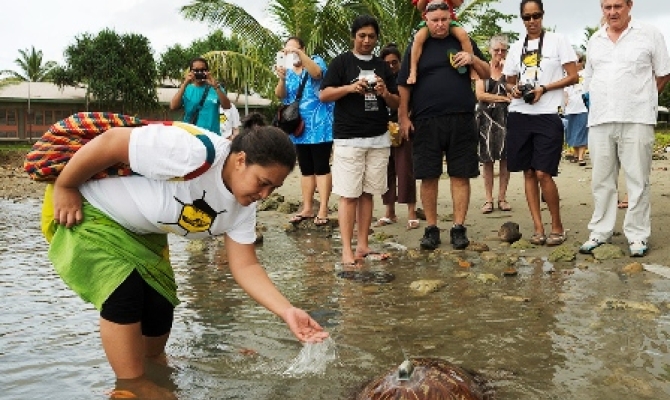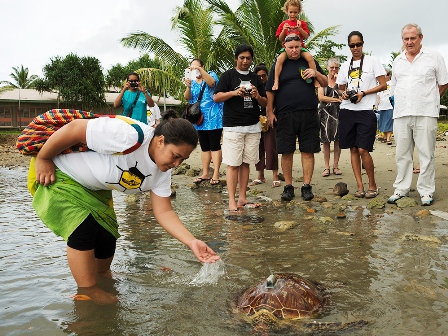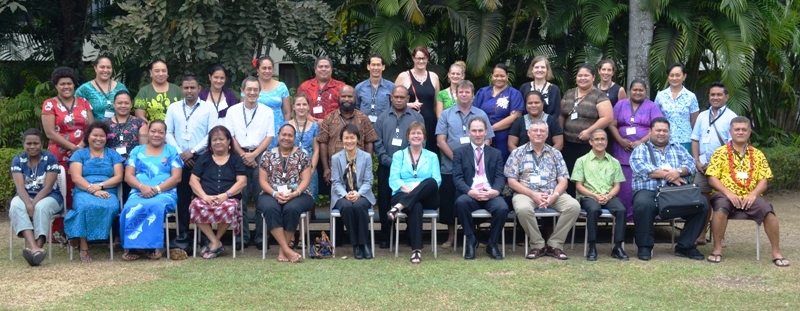
Island and Ocean Ecosystems
11 August, 2014, Nadi, Fiji - Conserving Pacific Biodiversity is the link that has brought Pacific islands together to prepare for three key international conferences stemming from global environment agreements they are party to. This is the first time a joint preparatory meeting is being held, coordinated in response to the call from Pacific islands for support to synergise efforts in meeting their obligations under the different agreements.
The Convention on Biological Diversity, the Convention on Migratory Species, and the Ramsar Convention on Wetlands are the three international agreements that will hold their Conferences of the Parties in 2014 and 2015.
 Tagging and release of turtles to commemorate the end of the
Tagging and release of turtles to commemorate the end of the
9th Pacific Islands Conference on Nature Conservation an Protected Areas in December 2013
This week the Secretariat of the Pacific Regional Environment Programme (SPREP) has come together with partners and countries to develop a synergistic Roadmap for Pacific engagement at these international conferences to help enhance conservation and protection of Pacific biodiversity.
"The unique biodiversity in this region and at this national level is still under tremendous risk and we need a common cooperative approach," said Mr. Stuart Chape, Director of Biodiversity and Ecosystem Management at SPREP.
"Let's make sure this week is not just a 'one off', let's all work together to continue strengthening our positive impacts."
The Pacific islands region covers 32 million square kilometres and is one of the most biologically rich regions on Earth. Incredibly diverse ecosystems occur on and around the 30,000 islands that make up the region's two per cent of land.
The huge expanse of ocean supports the most extensive and diverse coral reefs in the world, the largest tuna fishery, the deepest oceanic trenches and the healthiest and in some cases, largest remaining populations of many globally rare and threatened and migratory species including whales, sea turtles, and dugongs.

With different countries being party to all, several or just one of the three different biodiversity-related multilateral environment agreements, bringing all the parties together for the first time is a new milestone that will help make the work of the parties much easier. It will help harmonise and synergise efforts to implement national obligations under these agreements by assisting with administrative demands at the national level but more importantly, it will help with better protection of our Pacific biodiversity.
"As an institution supporting a synergistic approach towards multilateral environmental agreements, we are delighted to be part of this important meeting, which serves as an excellent example for other parts of the world in promoting a coordinated approach on MEAs," said Ms. Makiko Yashiro on behalf of Mr. Achim Stein, Executive Director of the United Nations Environment Programme.
"In this regard, we would like to congratulate colleagues from SPREP as well as secretariats of MEAs in facilitating and making concerted efforts for the organisation of this joint meeting."
The Pacific is home to a high proportion of endemic plant and animal species. However, Pacific Island biodiversity is under intense pressure from natural and human-induced disturbance, alien species introductions, population growth and other factors, and its indigenous plants and animals are among the most highly threatened in the world.
In South Korea in October this year, 194 country governments will meet for the Conference of the Parties to the Convention on Biological Diversity (CBD). 14 Parties are from the Pacific islands. In 2010 the Parties adopted five strategic goals with 20 targets to achieve by 2020, known as the Aichi Targets they are to inspire action in support of biodiversity over a decade. Each CBD COP held biannually is the opportunity to take national and regional stock against the targets.
"Since the adoption of the Strategic Plan for Biodiversity, we have seen more Parties actively translating the Aichi Biodiversity Targets into national targets as part of updating their national biodiversity strategies and action plans," said Mr. David Duthie of the CBD Secretariat. He was presenting an opening statement on behalf of Mr. Braulio Ferreira de Souza Dias, Executive Secretary of the Convention on Biological Diversity.
"This is an important step in the right direction as is the recent ratification by 51 countries, plus the European Union, of the Nagoya Protocol on Access to Genetic Resources and the Fair and Equitable Sharing of Benefits arising from their utlisation. However, the entry into force of the Nagoya Protocol on 12 October 2014 will be just the beginning of the story, not the end."
The Convention on Migratory Species (CMS) currently has seven parties from the Oceania Region with Fiji being one of the newest parties. Their Convention of the Parties will take place in Ecuador from 4 - 9 November this year. The Convention on Migratory Species, aims to conserve terrestrial, aquatic and avian migratory species throughout their range.
There are currently 23 marine species proposed for listing on the CMS list of threatened species that can benefit from conservation efforts. Twenty-one of these are sharks and stingrays, most of which are found in Pacific island waters.
"The Pacific island countries are leading the world in the protection you provide for sharks and other marine species with designation of the huge shark sanctuaries, Palau in 2009, then Tokelau, Marshall Islands, Federated States of Micronesia and Guam in 2011, and French Polynesia and Cook Islands in 2012," said Ms. Melanie Virtue, Head of the Aquatic Species Team of the CMS during her opening statement today.
"You have something valuable to share with the rest of the world, and at this COP, which is already being dubbed the 'Shark COP', it will be good to have a strong Pacific island voice to bring forward that message."
The International Ramsar Convention on Wetlands promotes national action and international cooperation for the conservation and wise use of wetlands and their resources. There are 168 contracting parties which include five Pacific island countries. To date there are 2,187 Wetlands of International importance culminating in over 200 million hectares in surface area of designated sites.
The work of the Ramsar Convention is contributing toward global sustainable development.
"The criteria for designating Ramsar Sites are either based on wetland ecosystems types, wetland species communities or globally threatened wetland species. The designation of Ramsar Sites therefore not only contributes to Ramsar's objectives, but also contributes to achieving CBD's objectives for biodiversity conservation and also CMS's objectives for the conservation of migratory species," stated Mr. Llewellyn Young of the Ramsar Convention in the opening statement he presented today on behalf of Dr. Christopher Briggs, Secretary General, Ramsar Convention on Wetlands.
"This is because many of the species found at the Ramsar Site are migratory and use the site for breeding, feeding or as a staging post during their migration. These species may include waterbirds, turtles, marine mammals such as dugongs, fish and so on. The 2,187 Ramsar Sites worldwide make up the largest network of sustainable managed areas globally and so help to protect the network of sites that migratory species depend upon."
The Pacific Joint Preparatory Meeting to the Convention of Biological Diversity COP12, Convention on Migratory Species COP 11 and Ramsar COP 12 is held in Nadi, Fiji from 11 to 15 August.
Countries represented at the one week conference are the Cook Islands, Fiji, Federated States of Micronesia, Kiribati, Marshall Islands, Nauru, New Zealand, Palau, Papua New Guinea, Samoa, Solomon Islands, Tokelau, Tuvalu and Vanuatu. Partners and stakeholders from the Pacific Islands Forum Secretariat, United Nations Development Program, WWF Pacific, UNEP, CBD, CMS, Convention on International Trade on Endangered Species (CITES).
The Convention on Biological Diversity, the Convention on Migratory Species, and the Ramsar Convention on Wetlands are the three international agreements that will hold their Conferences of the Parties in 2014 and 2015.
 Tagging and release of turtles to commemorate the end of the
Tagging and release of turtles to commemorate the end of the 9th Pacific Islands Conference on Nature Conservation an Protected Areas in December 2013
This week the Secretariat of the Pacific Regional Environment Programme (SPREP) has come together with partners and countries to develop a synergistic Roadmap for Pacific engagement at these international conferences to help enhance conservation and protection of Pacific biodiversity.
"The unique biodiversity in this region and at this national level is still under tremendous risk and we need a common cooperative approach," said Mr. Stuart Chape, Director of Biodiversity and Ecosystem Management at SPREP.
"Let's make sure this week is not just a 'one off', let's all work together to continue strengthening our positive impacts."
The Pacific islands region covers 32 million square kilometres and is one of the most biologically rich regions on Earth. Incredibly diverse ecosystems occur on and around the 30,000 islands that make up the region's two per cent of land.
The huge expanse of ocean supports the most extensive and diverse coral reefs in the world, the largest tuna fishery, the deepest oceanic trenches and the healthiest and in some cases, largest remaining populations of many globally rare and threatened and migratory species including whales, sea turtles, and dugongs.

With different countries being party to all, several or just one of the three different biodiversity-related multilateral environment agreements, bringing all the parties together for the first time is a new milestone that will help make the work of the parties much easier. It will help harmonise and synergise efforts to implement national obligations under these agreements by assisting with administrative demands at the national level but more importantly, it will help with better protection of our Pacific biodiversity.
"As an institution supporting a synergistic approach towards multilateral environmental agreements, we are delighted to be part of this important meeting, which serves as an excellent example for other parts of the world in promoting a coordinated approach on MEAs," said Ms. Makiko Yashiro on behalf of Mr. Achim Stein, Executive Director of the United Nations Environment Programme.
"In this regard, we would like to congratulate colleagues from SPREP as well as secretariats of MEAs in facilitating and making concerted efforts for the organisation of this joint meeting."
The Pacific is home to a high proportion of endemic plant and animal species. However, Pacific Island biodiversity is under intense pressure from natural and human-induced disturbance, alien species introductions, population growth and other factors, and its indigenous plants and animals are among the most highly threatened in the world.
In South Korea in October this year, 194 country governments will meet for the Conference of the Parties to the Convention on Biological Diversity (CBD). 14 Parties are from the Pacific islands. In 2010 the Parties adopted five strategic goals with 20 targets to achieve by 2020, known as the Aichi Targets they are to inspire action in support of biodiversity over a decade. Each CBD COP held biannually is the opportunity to take national and regional stock against the targets.
"Since the adoption of the Strategic Plan for Biodiversity, we have seen more Parties actively translating the Aichi Biodiversity Targets into national targets as part of updating their national biodiversity strategies and action plans," said Mr. David Duthie of the CBD Secretariat. He was presenting an opening statement on behalf of Mr. Braulio Ferreira de Souza Dias, Executive Secretary of the Convention on Biological Diversity.
"This is an important step in the right direction as is the recent ratification by 51 countries, plus the European Union, of the Nagoya Protocol on Access to Genetic Resources and the Fair and Equitable Sharing of Benefits arising from their utlisation. However, the entry into force of the Nagoya Protocol on 12 October 2014 will be just the beginning of the story, not the end."
The Convention on Migratory Species (CMS) currently has seven parties from the Oceania Region with Fiji being one of the newest parties. Their Convention of the Parties will take place in Ecuador from 4 - 9 November this year. The Convention on Migratory Species, aims to conserve terrestrial, aquatic and avian migratory species throughout their range.
There are currently 23 marine species proposed for listing on the CMS list of threatened species that can benefit from conservation efforts. Twenty-one of these are sharks and stingrays, most of which are found in Pacific island waters.
"The Pacific island countries are leading the world in the protection you provide for sharks and other marine species with designation of the huge shark sanctuaries, Palau in 2009, then Tokelau, Marshall Islands, Federated States of Micronesia and Guam in 2011, and French Polynesia and Cook Islands in 2012," said Ms. Melanie Virtue, Head of the Aquatic Species Team of the CMS during her opening statement today.
"You have something valuable to share with the rest of the world, and at this COP, which is already being dubbed the 'Shark COP', it will be good to have a strong Pacific island voice to bring forward that message."
The International Ramsar Convention on Wetlands promotes national action and international cooperation for the conservation and wise use of wetlands and their resources. There are 168 contracting parties which include five Pacific island countries. To date there are 2,187 Wetlands of International importance culminating in over 200 million hectares in surface area of designated sites.
The work of the Ramsar Convention is contributing toward global sustainable development.
"The criteria for designating Ramsar Sites are either based on wetland ecosystems types, wetland species communities or globally threatened wetland species. The designation of Ramsar Sites therefore not only contributes to Ramsar's objectives, but also contributes to achieving CBD's objectives for biodiversity conservation and also CMS's objectives for the conservation of migratory species," stated Mr. Llewellyn Young of the Ramsar Convention in the opening statement he presented today on behalf of Dr. Christopher Briggs, Secretary General, Ramsar Convention on Wetlands.
"This is because many of the species found at the Ramsar Site are migratory and use the site for breeding, feeding or as a staging post during their migration. These species may include waterbirds, turtles, marine mammals such as dugongs, fish and so on. The 2,187 Ramsar Sites worldwide make up the largest network of sustainable managed areas globally and so help to protect the network of sites that migratory species depend upon."
The Pacific Joint Preparatory Meeting to the Convention of Biological Diversity COP12, Convention on Migratory Species COP 11 and Ramsar COP 12 is held in Nadi, Fiji from 11 to 15 August.
Countries represented at the one week conference are the Cook Islands, Fiji, Federated States of Micronesia, Kiribati, Marshall Islands, Nauru, New Zealand, Palau, Papua New Guinea, Samoa, Solomon Islands, Tokelau, Tuvalu and Vanuatu. Partners and stakeholders from the Pacific Islands Forum Secretariat, United Nations Development Program, WWF Pacific, UNEP, CBD, CMS, Convention on International Trade on Endangered Species (CITES).